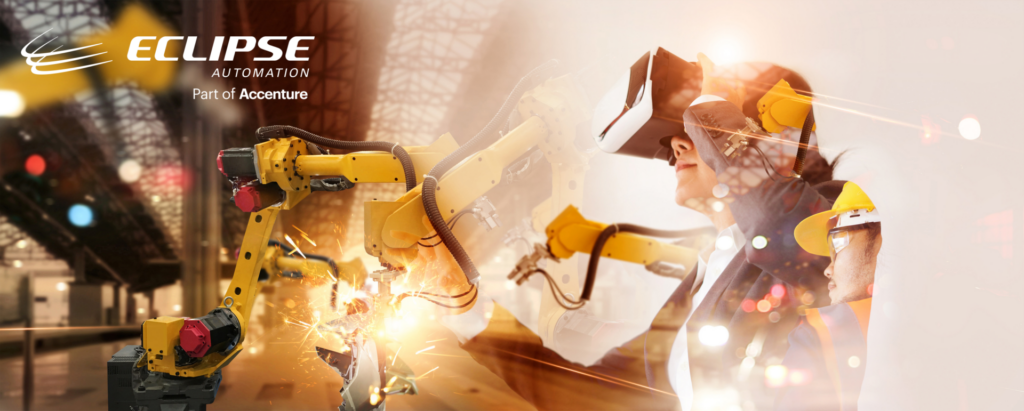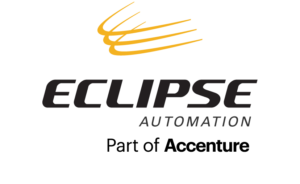
A look at Eclipse Automation’s competitive advantage
The term “digital twin” may be unfamiliar to you, but chances are, you already have an idea of what it means. Think flight simulator; a machine designed to resemble the cockpit of an aircraft, with computer-generated images that mimic a pilot’s view, and moveable controls. In short, it’s a virtual model of the real thing. The advantage is that the simulator can create risky scenarios, such as engine problems, electrical malfunctions, or maneuver mistakes without putting the pilot or others in any real danger.
De-risking rollout
In the world of automation, digital twinning technology opens up a world of applications, and along with them, many advantages. At Eclipse Automation, a part of Accenture, machine level digital twins are used to simulate the behaviours of mechanical, electrical, and software design during product development and prototype testing for the custom automation systems they design and build for widely recognized brands. The key benefit is that engineers can discover errors and correct them in the virtual machine before the physical machine is built, reducing risks and operational costs, including materials and labour, and also preventing downtime. Digital twins allow the project team to constantly monitor a machine, collect data on its performance, and compare it to its expected work performance. Using this data, they can identify and fix issues, and fine tune. The more that can be perfected before the building phase, the better, and through digital twinning, Eclipse is able to shorten the time to market.
Safe training environment
In Eclipse’s nuclear division, digital twinning has a practical health and safety application. In order to ensure worker safety, federal regulations and operational restrictions limit radiation dose exposure to personnel working in radioactive areas. These dose limits must be respected in order to not exceed a worker’s occupational exposure, so training for rad work must be performed on mock-ups that are expensive and in high demand. With the capability to create a simulator, Eclipse can train operators in a virtual environment, which is cheaper and more forgiving than traditional mock-ups. It also allows training for abnormal or upset conditions where workers may have to perform non-routine operations to recover from an abnormal condition. This provides a broader scope of training and means that personnel can be trained before the physical machine is ready for mock-up use, which greatly reduces ramp-up time and wear and tear on the physical equipment.
Faster, more cost-effective customer service
The benefits of digital twinning extend well beyond the walls of the many Eclipse facilities that dot the globe and go directly to their customers. Instead of a static, low-resolution rendering of their system, customers can now see a high-resolution, dynamic model of their system—a real plus for customers who have difficulty visualizing a system based on a drawing.
Immersive technologies, such as virtual reality (VR) and augmented reality (AR) open up new possibilities and allow Eclipse to offer a new level of service. In terms of VR, a customer would don a headset and be able to see the digital design space—a virtual world—and interact with it, using a joystick or hand gestures. They could see a system on their shop floor, that is not yet there without having to imagine it.
AR is known as the higher level of VR. It’s a place where digital and physical worlds converge. Wearing goggles, the user sees computer-generated graphics superimposed onto the real-world environment and can interact with equipment. Through AR, Eclipse can offer remote collaboration, walking a customer through their system, and if a system goes down, Eclipse can offer next-level service support with quick problem analysis and resolution by stepping the customer through a repair or maintenance process having total visibility of the system and being able to point to specific parts. VR offers the benefits of saving costs and time, and, with the increased focus on personal safety and social distancing, it eliminates the need to be physically present.
Looking forward
Digital twin is key to the development of Industry 4.0, the latest evolution of manufacturing, (also known as the fourth industrial revolution), which focuses on interconnectivity, automation, machine learning and real-time data. With its history, and the collective ingenuity of over 300 engineers, Eclipse is on its way to being a leader in smart manufacturing, with an eye on the lights-out manufacturing model, where every step of the manufacturing process is automated and requires little to no human interaction at all.
